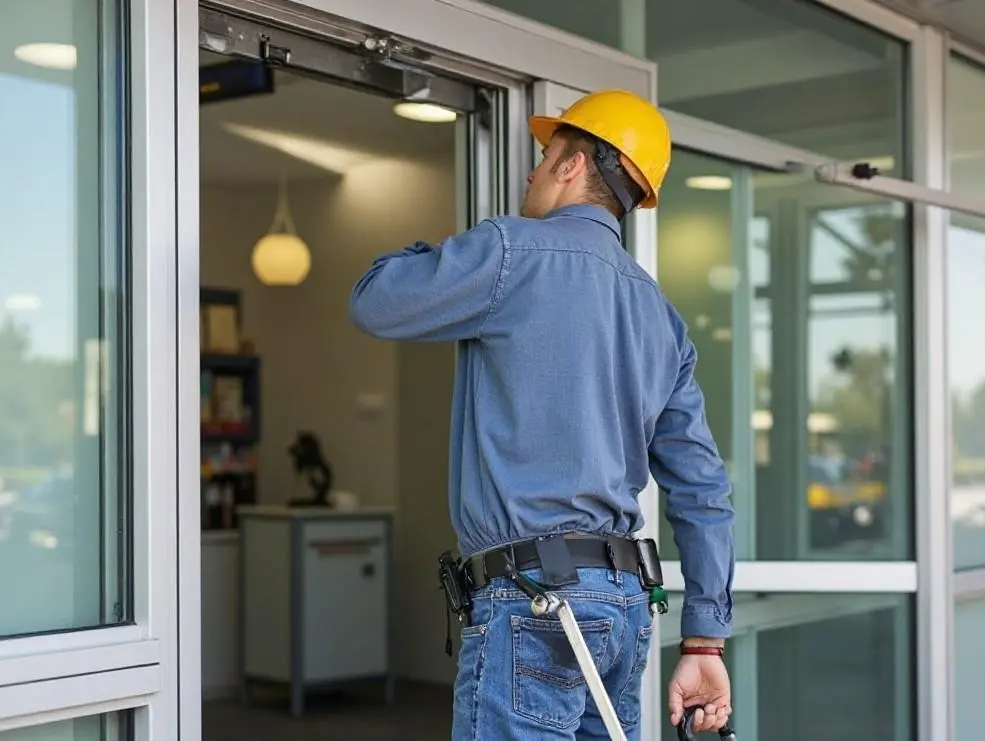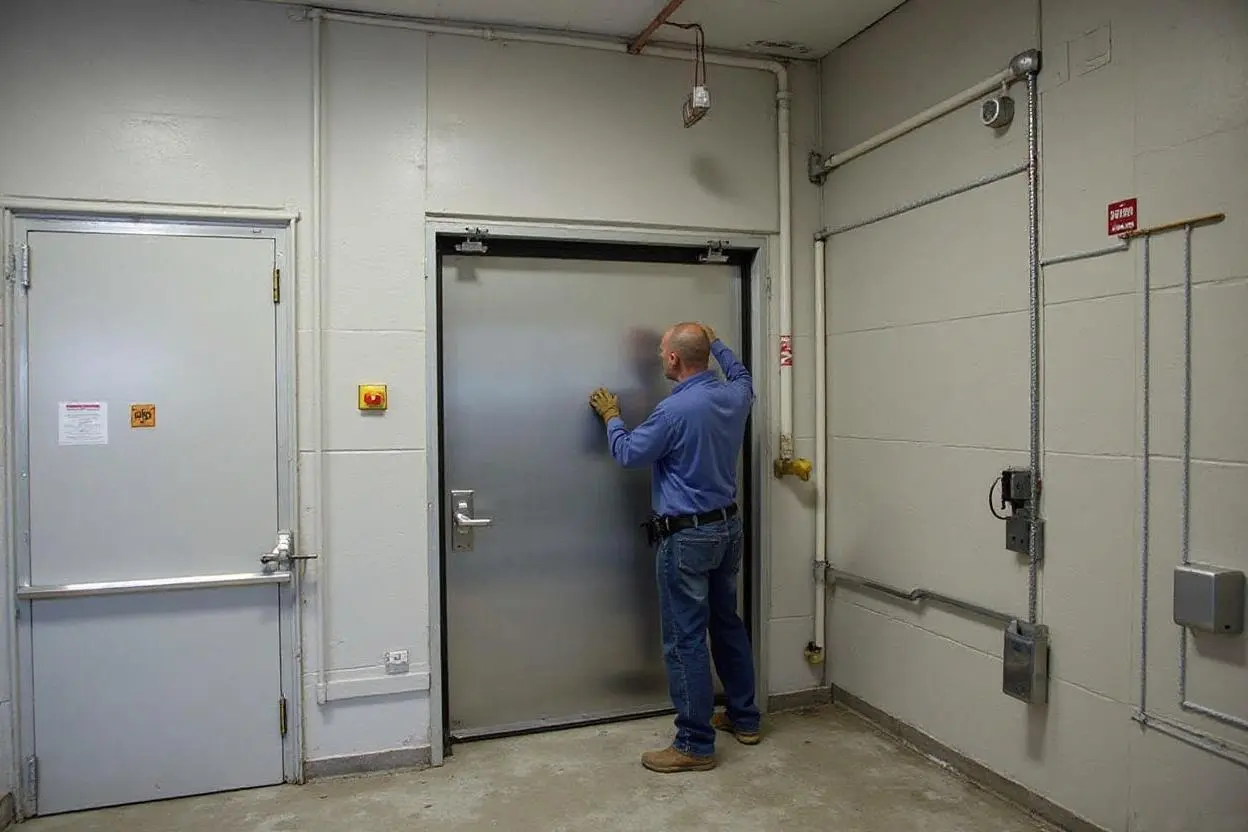How Hospitals and Schools in Buffalo Keep Automatic Doors Running Smoothly
Automatic sliding doors do quiet work. In a hospital corridor or a school vestibule, they manage traffic, infection control, ADA access, and simple convenience. When they fail, operations slow, safety falls, and costs climb. In Buffalo’s climate, with lake-effect snow and wind, keeping these doors reliable takes more than a casual service call. It takes routine care, data-driven checks, and quick, competent repairs.
What reliability means in a Buffalo facility
Hospitals in the Medical Campus, Amherst, and Cheektowaga handle round-the-clock foot traffic. Schools across the Buffalo Public Schools district face rushes at arrival, lunch, and dismissal. Automatic doors must open on cue, seal properly against drafts, and maintain clear egress during emergencies. A door that drags or hesitates creates a lineup, while a sensor blind spot can cause impact risks.
A-24 Hour Door National Inc. works with facilities across Erie County to keep systems healthy under real usage. Teams see the same patterns across brands: dust and salt in the tracks, sensor misalignment after deep cleaning, weak power supplies on older controllers, and belt wear after heavy traffic days.
The core routine: what successful facilities do every month
Facilities that avoid breakdowns follow a simple rhythm. They schedule quarterly inspections and keep a brief monthly checklist for custodial teams. The structure is boring by design, which is why it works.
- Clean the threshold and track: remove grit, road salt, ice melt residue, and gum. A clean track prevents drag and belt overwork.
- Wipe and test sensors: both activation sensors and presence sensors. Confirm approach detection zones and safety hold-open function.
- Inspect weather seals and brush strips: look for gaps and tears that invite drafts and slush.
- Observe door travel: listen for squeaks, watch for shudder at start or end of travel, and check speed and smooth deceleration.
- Check signage and sightlines: clear window decals, correct push-to-open button placement, and visible emergency exit instructions.
This simple loop catches 70 to 80 percent of issues before they interrupt service.
Hospital realities: infection control, quiet operation, and redundancy
In healthcare, automatic doors are part of care delivery. Isolation rooms need reliable closing force and seal integrity. Surgical corridors need quiet operation near sensitive spaces. Behavioral health units need controlled access with specific hold-open times.
Maintenance must respect infection control protocols. Technicians plan work around negative pressure rooms and bring approved cleaning agents. Service windows often land late at night or early morning to avoid post-op traffic. Teams bring spare belts, rollers, and logic boards to keep a single visit productive, because a stalled ICU corridor door at 6 a.m. is not acceptable.
Buffalo’s winters complicate entrances. Vestibules at hospitals near Main Street or Delaware Avenue see repeated temperature swings. That expands and contracts aluminum components, loosening sensor brackets. A-24 Hour Door National Inc. often adds periodic torque checks for mounting hardware from November through March and adjusts close force and speed profiles for cold-weather friction.
School needs: crowd flow, safety, and limited budgets
Public and private schools in North Buffalo, South Buffalo, and West Side face sharp peaks in foot traffic. Doors must read small and tall pedestrians, backpacks, and carts without false triggers from snow flurries. Playground grit and rock salt build up in thresholds quickly.
Custodial crews usually handle weekly track cleaning and basic visual checks. They document door counts after big events like basketball games or concerts and report sensor anomalies. Because budgets are tight, schools benefit from a seasonal plan: pre-winter tune-up in October, mid-winter check in January, and a spring service to reset for testing season, graduations, and summer programs. Grouping multiple buildings on a single service day keeps costs predictable and helps with NYSED compliance documentation.
Common failure points seen across Buffalo
Patterns repeat across facilities, brands, and neighborhoods. Knowing these saves time during service calls.
- Contamination in the track: salt and grit act like sandpaper. Belts slip and motors draw higher current.
- Sensor drift: a ceiling tile bump or a deep clean can shift radar presence sensors by a few degrees, creating dead zones.
- Roller wear: flat spots cause a rhythmic thump and slow starts that staff often shrug off until a full stop occurs.
- Power supply fatigue: older controllers show intermittent resets during voltage dips on cold mornings.
- Belt tension: too tight strains bearings; too loose causes chatter, stalls, and mis-learned door travel.
An experienced tech checks these in a fixed order, which often resolves issues without part replacement.
Code, liability, and why paperwork matters
Hospitals and schools must meet ANSI/BHMA A156.10 and A156.38 standards for power-operated pedestrian doors. Local inspectors and insurance carriers ask for documented inspections and daily safety checks. In Buffalo, risk managers frequently require a quick-function test each morning:

- Wave or approach to activate, confirm opening and hold-open time.
- Break the threshold beam to confirm safety stops closing.
- Use the push-to-open button, confirm ADA compliance.
- Verify emergency breakout (on systems with that feature), then reset.
A-24 Hour Door National Inc. leaves a simple log sheet at each door and trains staff to complete it in under 60 seconds. In the event of an incident, that record protects the facility and guides root-cause analysis.
Winter is a maintenance season, not a surprise
Lake-effect snow dumps moisture and salt where doors are most vulnerable. Facilities that stay ahead of trouble do three things before the first freeze:

- Increase cleaning frequency for tracks and sensor lenses.
- Add mats and scraper grates to reduce debris entering the threshold.
- Adjust closing speeds and lubricants for cold temperatures approved by the manufacturer.
In practice, these steps cut winter service calls by a third. It also lowers heating costs because doors seal better and avoid unnecessary hold-open time in high winds.
Replacement vs. repair: a practical decision framework
A controller board from the mid-2000s might accept a repair, but lack current safety features and be hard to source. Technicians weigh part availability, total cycle count, and building needs. If a hospital vestibule runs 2,500 cycles a day and shows repeated belt and roller wear, a modernization kit can pay back in two to four years through fewer calls and better energy control. For a small school entrance with 300 cycles a day, a targeted repair may be the right call for another three to five years of service.
A-24 Hour Door National Inc. presents both options with clear pricing, lead times, and downtime expectations. For live facilities, they often stage work so one leaf stays operational while the other undergoes repair, or they schedule after-hours work to keep entrances open during the day.
What “automatic sliding doors repair Buffalo” looks like on a live call
A typical call in Elmwood Village starts with a complaint: door hesitates, then closes too hard. The tech arrives with brand-specific tools, isolates power, and inspects the track. They find compacted salt, a stretched belt, and a presence sensor tilted upward. After cleaning, they set correct belt tension, square the door, recalibrate open and close speeds, and test safety zones with a cart and a wheelchair. The door runs smoothly, staff sign the log, and the tech suggests a mid-winter check in six weeks.
On another job near South Park, a school entrance shows intermittent opening during snow squalls. The radar sensor was reading blowing snow as foot traffic. The fix involved narrowing the detection zone and raising the sensitivity threshold slightly, then verifying with a student flow test at dismissal. The issue did not return.
Budget control without cutting safety
Facilities worry about rising service rates. The most reliable cost controls are simple: fewer emergency calls through routine care, consolidated service windows, and part standardization. Many Buffalo campuses have mixed brands across entrances. Standardizing on a small set of controllers and sensors reduces truck rolls, training time automatic doors for staff, and spare parts inventory. A-24 Hour Door National Inc. helps inventory existing equipment and propose a reasonable path to standardization during normal replacement cycles.
What to expect from a professional service partner
A good partner brings parts, experience, and respect for operations. For hospitals and schools, that includes background-checked technicians, proof of insurance, lift certification where needed, and clean work practices. The team should communicate in plain language, quote before work, and leave the entrance cleaner than they found it. They should also train onsite staff to spot early signs: a slight drag, a new noise, or a sensor that misses small children or wheelchairs.
If a facility needs automatic sliding doors repair Buffalo-wide, A-24 Hour Door National Inc. offers same-day response for urgent closures, 24/7 coverage for true emergencies, and scheduled maintenance across Buffalo, Amherst, Cheektowaga, Tonawanda, West Seneca, and Orchard Park.
A simple plan to keep doors running
- Schedule a pre-winter tune-up and a spring reset for every entrance.
- Assign a weekly five-minute cleaning and observation task to custodial staff.
- Keep a door log for daily safety checks and service records.
- Standardize key parts across entrances as replacements occur.
- Partner with a local team that understands Buffalo weather, school calendars, and hospital traffic.
Automatic doors should feel invisible. With steady maintenance, smart settings, and quick, competent service, they do. For reliable automatic sliding doors repair Buffalo facilities can count on, contact A-24 Hour Door National Inc. to set up a maintenance visit or request an urgent repair today.
A-24 Hour Door National Inc provides commercial and residential door repair in Buffalo, NY. Our technicians service and replace a wide range of entry systems, including automatic business doors, hollow metal frames, storefront entrances, fire-rated steel and wood doors, and both sectional and rolling steel garage doors. We’re available 24/7, including holidays, to deliver emergency repairs and keep your property secure. Our service trucks arrive fully stocked with hardware, tools, and replacement parts to minimize downtime and restore safe, reliable access. Whether you need a new door installed or fast repair to get your business back up and running, our team is ready to help. A-24 Hour Door National Inc
344 Sycamore St Phone: (716) 894-2000 Website: https://a24hour.biz/buffalo
Instagram: @a24hourdoor
Buffalo,
NY
14204,
USA
Facebook: 24 Hour Door
Yelp: A-24 Hour Door National (Buffalo)
X (Twitter): @a24hrdoor